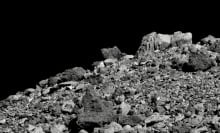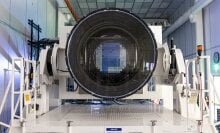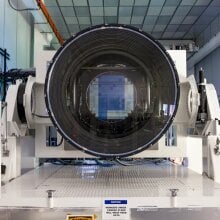NASA regularly posts highly impressive GIFs of glimpses beyond our own atmosphere, and this week, it's another beauty from Mars.
On Thursday, the space agency's Curiosity rover posted two animated images showing the six-wheeled vehicle's view of the Martian landscape over 12 hours. It's essentially the representation of one Martian day, from sunrise to sunset, with Curiosity capturing its own shadow in the foreground.
"Hey look – I’m a sundial!" tweeted the official Curiosity account. "Ok, not exactly, but I did get a sol to enjoy my surroundings. During solar conjunction, I used my hazard cameras to study the Martian weather and dust."
Tweet may have been deleted
You can see the second set of images on NASA's Mars website.
Curiosity's photos were taken on Nov. 8 from 5:30 a.m. to 5:30 p.m. local time. The view is looking southeast (front camera) and northwest (rear camera) from the Gediz Vallis Ridge, where Curiosity recently (and triumphantly) arrived — a major stop on its steady climb of Mount Sharp in Gale Crater, ongoing since 2014.
They were snapped using the rover's front and rear Hazard-Avoidance Cameras, known as hazcams (cameras that not only help the robot identify obstacles and tricky terrain, but brought us all kinds of glorious Mars imagery). According to NASA, the rover was commanded to record them before the Mars solar conjunction, when the Sun rudely sits between Mars and Earth and messes up communications — it's an approximately two-week period that happens every two years.
NASA scientists were hoping to capture some Martian clouds or dust devils, and while they didn't get any weather in the photos, the stitched clips are a glorious example of a Martian day — and Curiosity's presence during it.
"As the sky brightens during sunrise, the shadow of the rover’s 7-foot (2-meter) robotic arm moves to the left, and Curiosity’s front wheels emerge from the darkness on either side of the frame. Also becoming visible at left is a circular calibration target mounted on the shoulder of the robotic arm," reads NASA's blog post. "Engineers use the target to test the accuracy of the Alpha Particle X-ray Spectrometer, an instrument that detects chemical elements on the Martian surface.
"In the middle of the day, the front Hazcam’s autoexposure algorithm settles on exposure times of around one-third of a second. By nightfall, that exposure time grows to more than a minute, causing the typical sensor noise known as “hot pixels” that appears as white snow across the final image."
As for the spots on the cameras? Well, you don't careen around Mars for 11 years without getting a little dust on the lens.
Topics NASA































